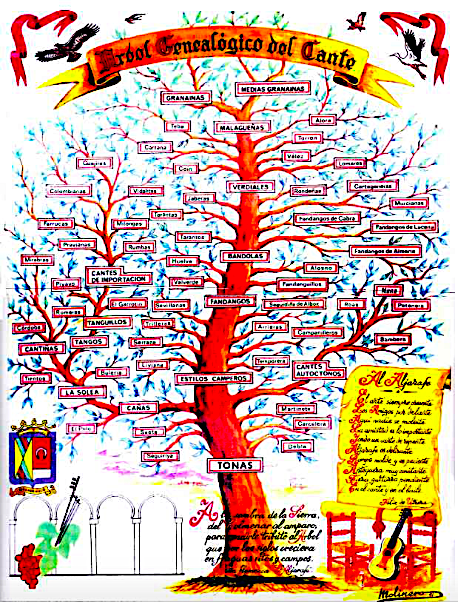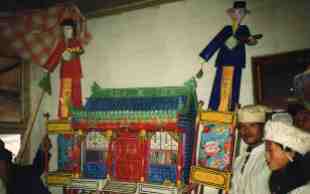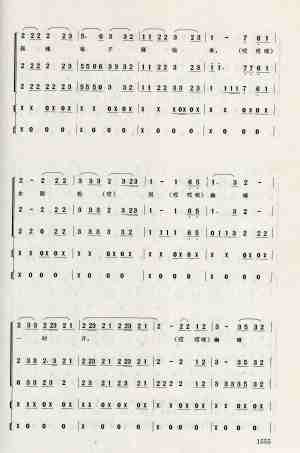
After an interlude on ritual around south Jiangsu (notably the great Daoist ritual held in Suzhou in 1956), here I return to my home base of north China, focusing on the Maoist era as a kind of prequel to my post on the Wutaishan Buddhists.
As always, I note the tension between studies of ritual and “music”. Whereas scholars of religion tend to focus on early doctrine and silent texts, Chinese music scholars set forth from the living soundscapes of ritual. At the same time, they have tended to collect reified “pieces of music”, only paying attention to ethnography quite recently. However, at least they do the fieldwork, stressing the actual performance of ritual, and we can glean clues to the changing life of religion in society.
Wutaishan
Wutaishan is one of the foremost sites for Buddhism in north China. Since the 1980s, the history of its temples has become a major research topic, [1] and Chinese music scholars have documented their rituals (for an introduction, see my Folk music of China, pp.213–25). But already in 1947, amidst civil war and land reform, Ya Xin spent three months on Wutaishan documenting the ritual soundscape (whose features in north China I introduce here).
Following the national Communist victory in 1949, major projects to document a wide range of folk musical genres were initiated right across China. In March 1954 Ya Xin took part in a conference in Chengdu to discuss the enterprise, prompting him and five others to spend August doing fieldwork in the temples of Emeishan in Sichuan. In 1955 he edited a 508-page volume of transcriptions, including both that material and his 1947 work on Wutaishan:
- Ya Xin 亞欣, Siyuan yinyue 寺院音樂 [Temple music], Zhongguo yinyuejia xiehui Chengdu fenhui, 1955.
By the 1950s, scholars like Yang Yinliu studying “religious music” found it obligatory to defend the “value” of the topic, and Ya Xin prefaced his introduction (pp.1–15) with such a defence. The following transcriptions for Emeishan (pp.16–297) include the major Yuqie yankou ritual, daily services, and other vocal liturgy. [2]
But back in 1947 (just as Bill Hinton was embedded with the land reform teams in a village further south in Shanxi), Ya Xin had carried out fieldwork on Wutaishan while serving as a cultural cadre for the Jin–Sui Liberated Area. The conditions were most taxing: amidst ongoing battles with Nationalist troops, the Communists were implementing land reform. So Ya Xin notes that his work was imperfect. But it was a bold initiative: while collecting folk music had been a major project in the Shaanbei Base Area, temple ritual was not on their agenda.
For Wutaishan (pp.299–454), Ya Xin transcribed the main items from the Yuqie yankou ritual, shengguan wind ensemble melodies for both Han Chinese (qingmiao) and Tibeto-Mongolian (huangmiao) styles, and the Three Days and Nights (san zhouye) mortuary ritual. With the book’s many transcriptions of hymns (zan 讚), gathas (ji 偈), mantras (zhenyan 真言), and so on, it provided an early framework for understanding the mechanics of vocal liturgy.

From Ya Xin’s transcriptions of the Wutaishan yankou: Daochang chengjiu hymn,
and opening of Huayan hui, showing melisma with padding characters.
Finally, visiting Du Wanzhongshan’s gufang 鼓房 folk wind band in Dongye town at the foot of the mountain Ya Xin notated their “eight great suites” (pp.455–508), derived from the shengguan of the temple monks (Folk music of China, pp.218–19)—although unlike groups of household ritual specialists, they don’t perform vocal liturgy.
Since Ya Xin wasn’t equipped with a recording machine, one both admires his diligence in transcription and wonders at its accuracy. I surmise that much of his work on the vocal liturgy was done with individual monks singing items for him repeatedly, rather than in the course of rituals—not least because the Buddhist texts themselves are highly complex, so he clearly had access to ritual manuals; and he seems to have consulted gongche scores of the shengguan music too. But he didn’t list the temples where he made his transcriptions, or provide names of monks.
Background
We should bear in mind the wider history of Wutaishan around the time. Here I seek clues in the 1988 Wutai county gazetteer. [3] Though such sources are “history of the victors”, they contain some useful material.
Warlord conflict from the 1920s, with Yan Xishan’s troops active, already made the region unstable. But in 1936 Wutaishan had 130 active temples with 2,200 registered clerics (including 800 lamas)—many of whom were doubtless fleeing from warfare. John Blofeld spent time there in 1936–37.
The early architecture of the Wutaishan temples had attracted historians for some time. Japanese scholars found some important temples early in the 20th century, though the Danish Johannes Prip-Møller was unable to visit during his 1929–33 temple survey. In 1937, on the eve of the invasion, Liang Sicheng and Lin Huiyin rediscovered the Tang-dynasty Foguang si temple. The search for “living fossils” would later become a major industry in Chinese musicology.
Japanese troops invaded the area in October 1938, carrying out several massacres. This was an early base area for the Communists in the resistance against Japan. Both patriotic and quisling Buddhist associations were formed in the temples. Many of the monks assisting the resistance were Tibeto-Mongolian lamas, such as those of the Zhenhai si temple, who in 1938 handed over to the 8th Route Army an entire arsenal of weapons that had been given by Chiang Kai-shek to the bodyguard of the Zhangjiafo lama. Monks handed over another cache of weapons in 1942.
The Nationalists fled in 1943, and the Japanese were in retreat from 1944. By July 1946 the Communists were in complete control, and began carrying out land reform. The monks now lost much of their land and income, and some temples were destroyed. By 1947, with little patronage, tilling the monks’ remaining land constituted 89% of their income.
Yan Xishan’s forces returned in October 1946, but retreated again in November. Even in February 1949 they committed a massacre in Dongye town.
During this whole period from 1937 a succession of Communist leaders had passed through. After Chairman Mao’s 1947 visit to the White Cloud Temple in Shaanbei, on a trip to Wutaishan in 1948 he expressed appreciation of the cultural heritage of Buddhism (for many such comments see e.g. here). Such utterances might have offered a certain intermittent validation for research, though they are utterly paltry alongside the Party’s long-term onslaught on religion.
Upon Liberation and over the following years, most temple clerics were laicized, with their traditional patronage severely reduced. The remaining monks on Wutaishan (a 1956 survey lists 445) [4] received a monthly income of 20–40 yuan from the county government. During the Maoist era ritual life was doubtless much impoverished, though the authorities sanctioned occasional visits from overseas Buddhist delegations.
Meanwhile, away from the temples, household ritual specialists, their numbers now boosted by clerics returning to the laity, maintained a certain activity. And although the influence of Wutaishan made Buddhism dominant around the region, Daoist ritual specialists were also active, such as in nearby Xinzhou.
Sects
Sectarian groups are another major theme in religious life throughout China. The sectarian connections of the amateur ritual associations in central Hebei, whose liturgy was transmitted from temples, are a separate case. But all these sects should interest us, since while not all of them performed complex liturgy, they show a link between temple and lay practice.
It is not that Buddhist monks or Daoist priests were usually sectarian; often, as in Yanggao, occupational ritual specialists are clearly distinct from the sects. But I have a growing list of temples where clerics belonged to such groups (Tianzhen, Xinzhou, Baiyunshan).
The recent county gazetteers, however partial, are often a useful source on the sects. Major campaigns were held from 1950 to 1951, and continued through into the Cultural Revolution. Of course, campaigns against “heterodox teachings” were nothing new, having been frequent under both imperial and republican governments, but the new campaigns were far more ruthless. Still, the sects went underground as usual, and have revived since the 1980s. However partial such recent accounts may be, it is important to bear in mind this perspective on local religious organizations when we consider the practice of folk ritual over the last century; this background still colours local society, and our discussions, today.
In the Wutai region, despite campaigns since 1945, intensifying in 1949 and 1950, a variety of sectarian groups were still active through the 1950s, including the Jiugong dao, Huanxiang dao, and Houtian dao. [5] They had a firm base in the temples as well as throughout the countryside. A brief biography of Zhang San Baotai 张三保泰 (1890–1958), [6] leader of the Houtian dao sect, is so rare as to be worth summarizing.
After joining the sect in 1924, Zhang became a monk at the Yuanzhao si temple on Wutaishan in 1938. The following year he declared himself a living Buddha, but his plot with Yan Xishan’s troops to organize an underground arsenal was exposed. In 1941 he travelled through Shanxi, Hebei, and Shandong, recruiting over ten thousand followers. His activities continued under the PRC, despite the campaigns of 1950–51. After returning to Wutai from Yuxian in Hebei in 1955, he prepared a major armed uprising for 1960, planning to establish a capital at Dingxian in Hebei, and mobilizing in Shandong; but he was captured and executed in 1958.
Apart from the general persecution of “orthodox” religious practices, the sectarian connection would have further darkened the cloud hanging over the temples.
Research in the 1950s
I know of no fieldwork on the rituals of the Wutaishan temples after Liberation. Still, eighteen monks from Wutaishan took part in a provincial festival of folk music at Taiyuan in 1958, winning a prize. Provincial scholars were hoping to do fieldwork from the mid-1950s, but were unable to do so. [7]
The “eight great suites”
The folk shengguan instrumental bands made a more palatable topic than the vocal liturgy of the temples, and this style did go on to achieve wider fame. In 1953 the Shanxi Radio Station revisited Du Wanzhongshan’s band in Dongye to record, which were widely broadcast, and Liu Shiying 刘士英 published transcriptions.

Bapaizi melody for shengguan, in Zhongguo yinyueshi cankao tupian.
Indeed, early in the War against Japan a friend of Bo Yibo, then a major Communist resistance leader in Shanxi, had lent a 1926 gongche score of this repertoire to Lü Ji, who would become the pre-eminent official pundit of Chinese music. After Liberation Lü Ji lent the score to Yang Yinliu; [8] a page was reproduced in vol.4 of the 1957 Zhongguo yinyueshi cankao tupian 中国音乐史参考图片, spreading awareness of the genre in music circles.
Even as the enforcement of the commune system was leading to desperation, further recordings of the suites, along with transcriptions, were made from 1959, with Du’s son Du San now leading the band.
When I first visited Wutaishan in 1986 it was still far from a bustling national and international tourist attraction. Indeed, I needed a special permit to travel there. Even the town of Taihuai was still a tranquil retreat. But my attention soon turned from the temples to folk ritual practice, and on my later trips I explored household groups in the surrounding region, including a fine shengguan band in Dongye town, led by Xu Yousheng. In 1992, having followed them round on funerals, we held a recording session (#5 on CD1 of my China: folk instrumental traditions; or a shorter version as #5 of the CD with the 1998 paperback of Folk music of China).
Since the reforms
The provincial scholars who had planned fieldwork on Wutaishan in the mid-1950s were only able to realize the project after the end of the Cultural Revolution, leaping into action as early as 1978. A group of senior monks was invited to the Shanxi Music and Dance Research Institute that year, and the precious recordings (as well as some further tracks from 1988) were issued on the five-cassette series
- Wutaishan foyue 五台山佛乐, with notes by Liu Jianchang, in The Audio and Video Encyclopedia of China series, ed. Tian Qing (Shanghai yinxiang gongsi, 1989; reissued on CD since 1998). [9]
The set includes both vocal liturgy and shengguan ensemble music, with excerpts from the yankou ritual and examples of both Han Chinese (qingmiao) and Tibeto-Mongolian (huangmiao) styles. Like the group that came to England in 1992, most of the performers had been ordained on Wutaishan but had spent much of the Maoist era elsewhere in Shanxi, doing rituals sporadically among the folk. And meanwhile the “southern” style of vocal liturgy was replacing the distinctive regional styles of northern temples (such as Beijing and Shenyang).

From 1978 to 1980, Chen Jiabin and Liu Jianchang published transcriptions in mimeograph, and by the 1980s, along with the Anthology fieldwork, several provincial scholars were undertaking studies. The most extensive research is
- Han Jun 韩军, Wutaishan fojiao yinyue zonglun 五台山佛教音乐总论 (2012).
The Anthology coverage is also substantial:
- Zhongguo minzu minjian qiyuequ jicheng, Shanxi juan 中国民族民间器乐曲集成, 山西卷 (2000), introduction pp.1543–53, transcriptions 1554–1768.
The yankou: opening of Huayan hui hymn, from Anthology. For variant renditions, see Han Jun, Wutaishan fojiao yinyue zonglun, pp.152–5.
Such studies suffer from the usual flaws of Chinese research, consisting mainly of reified transcriptions rather than ethnography, but they contain some clues to the changing fortunes of religious life.
Meanwhile, as with groups such as the Zhihua temple, media coverage steered clear of the ritual basis of the tradition by highlighting the shengguan instrumental ensemble, with glossy performances on stage.
- Beth Szczepanski, The instrumental music of Wutaishan’s Buddhist monasteries (2012)
also mainly focuses on the shengguan ensemble, but she takes a more ethnographic approach, with useful sections on the vocal liturgy; notes on actual rituals observed, including a funeral; and astute comments on the ideological baggage of Chinese studies and the recent commodified market.
* * *
In the West the study of Chinese ritual is often considered to date from the work of Kristofer Schipper in Taiwan in the 1960s; and in the PRC much of the vast energy in researching local ritual traditions has taken place since the 1980s.
However, long before scholars of religion, fieldworkers in mainland China, in the Republican era and under Maoism, were hard at work documenting ritual practice—their studies conducted under the discreet guise of “music”. [10] It was the intrepid fieldwork of such scholars before 1965, despite all the ideological obstacles then placed in their way, that formed the background to the monumental Anthology project of the 1980s. While most Chinese music scholars working on northern ritual traditions stress the shengguan ensemble, they don’t neglect the vocal liturgy.
Most scholars of Buddhism, and indeed Daoism, are more concerned with early doctrinal issues and the material heritage than with ritual performance. But as I constantly stress, if we wish to study religion in China, we must get to grips with its soundscape. And even this barely addresses my main concern—the changing ritual life of local communities.
[1] Note e.g. the journal Wutaishan yanjiu 五台山研究, and the recent volume Yishan er wuding: duoxueke, kuafangyu, chaowenhua shiyexiade Wutai xinyang yanjiu 一山而五頂:多學科,跨方域,超文化視野下的五台信仰研究 [One mountain of five plateaus: studies of the Wutai cult in multidisciplinary, crossborder and transcultural approaches], ed. Miaojiang 妙江, Chen Jinhua 陳金華, Kuan Guang 寬廣 (Taipei: Xinwenfeng, 2017).
[2] Yang Yinliu had visited Qingchengshan in the summer of 1942, but his attempts to transcribe vocal liturgy there were frustrated by an unhelpful abbot (see his 1961 essay “How to treat religious music”). BTW, folk and temple ritual in the vast province of Sichuan is also a major topic that I can’t begin to address—as ever, the Anthology is one starting-point, and Volker Olles can provide leads.
[3] Besides other essays in the Wutai xianzhi, for “major events” of the Republican and Maoist eras, see pp.696–714. See also Beth Szczepanski, The instrumental music of Wutaishan’s Buddhist monasteries (2012), pp.10–21. For more background, see Holmes Welch, Buddhism under Mao (1972).
[4] Wutai xianzhi, p.581.
[5] Wutai xianzhi, pp.576–7, 603.
[6] Wutai xianzhi, p.643.
[7] Liu Jianchang 刘建昌, Chen Jiabin 陈家滨, and Ren Deze 任德泽, “Shanxi zongjiao yinyue diaocha baogao” 山西宗教音乐调查报告, Yinyue wudao 1990.1.
[8] Yang Yinliu yinyue lunwen xuanji (1986), prelude by Lü Ji, p.3.
[9] Cf. Szczepanski, The instrumental music of Wutaishan’s Buddhist monasteries, pp.128–9. Of course, rituals such as the yankou, with its complex Tantric mudras, cry out to be documented on film. For a brief 2003 excerpt from a yankou in a minor temple in Yanggao, led by a monk trained at Wutaishan, see my film Doing Things.
[10] Cf. my In search of the folk Daoists of north China, pp.20–26.


































































